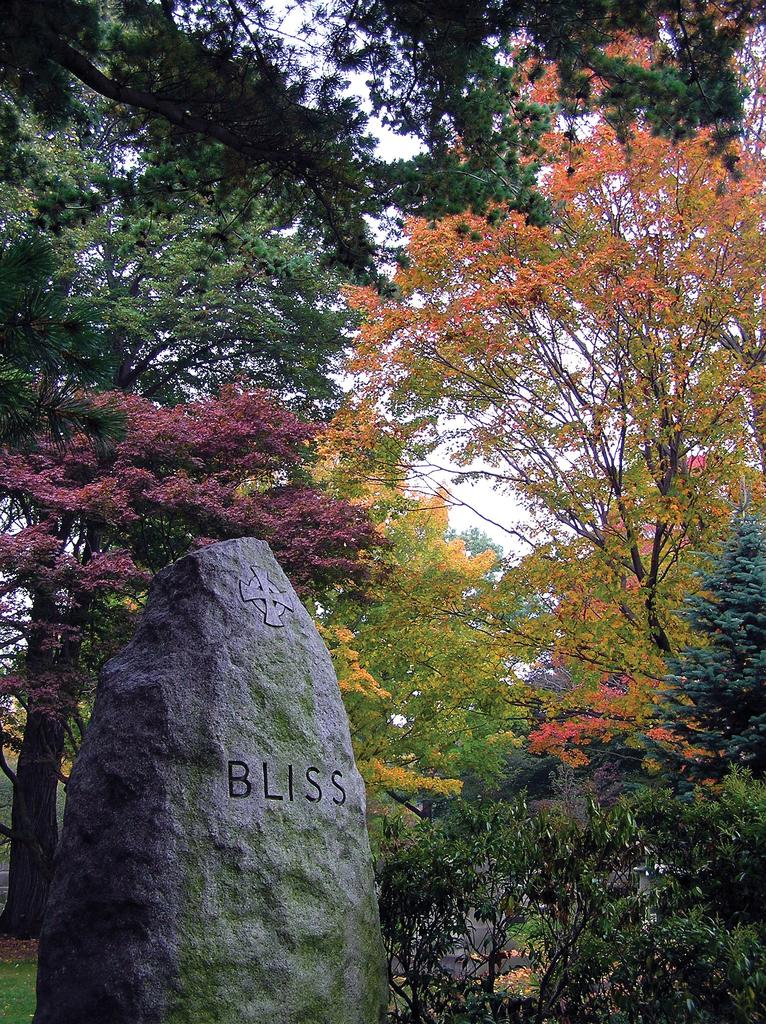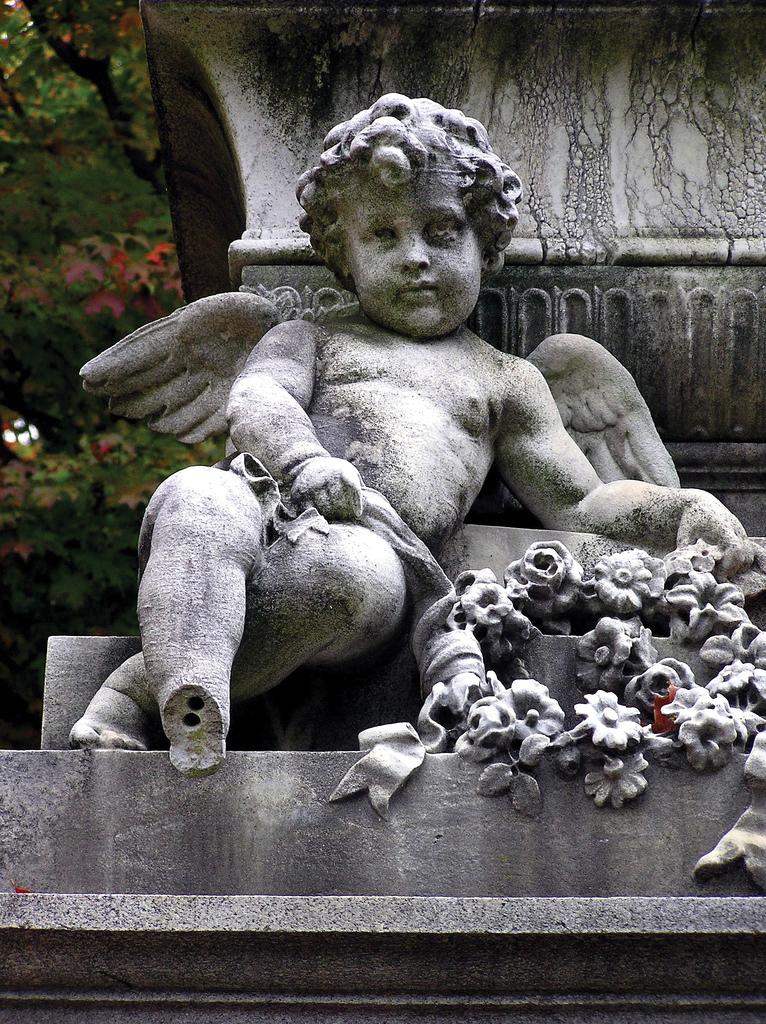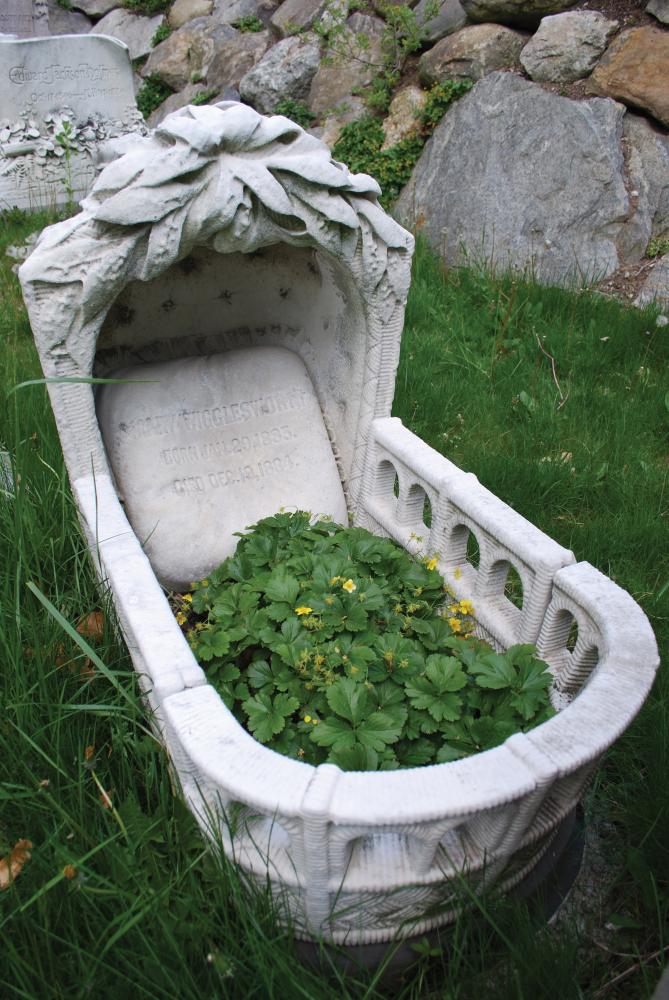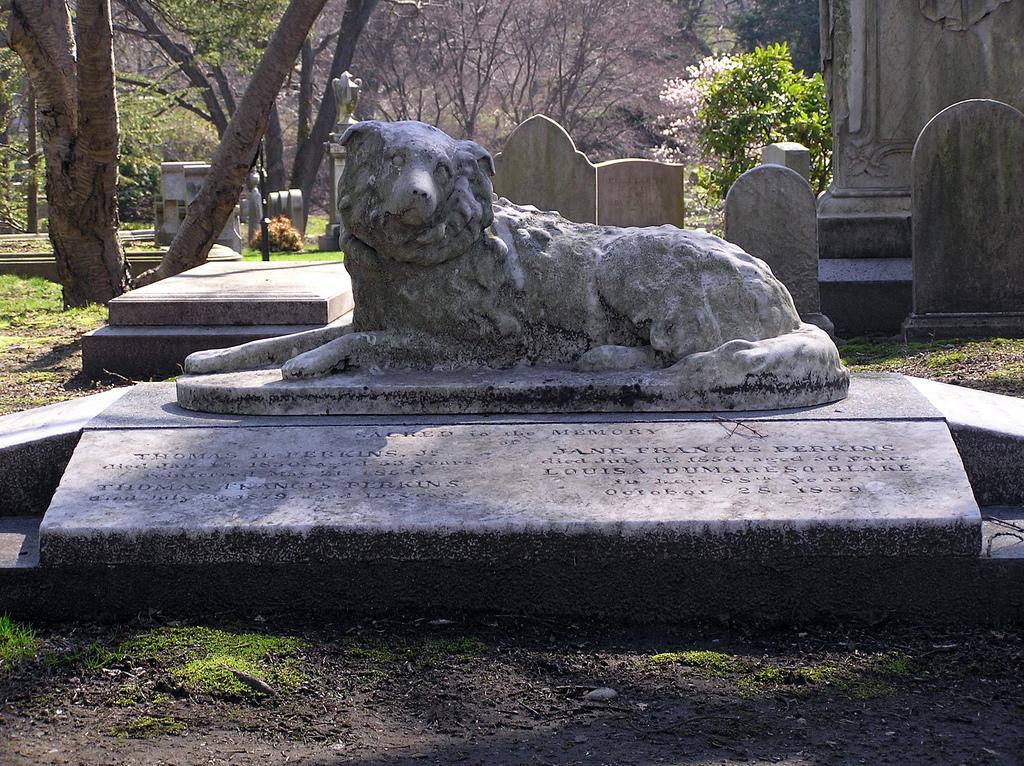Not far from the Harvard University campus, in Cambridge, Massachusetts, Mt. Auburn Street is busy and clogged with traffic during the morning rush hour as commuters and their cars creep across the urban landscape of auto shops, supermarkets, and liquor stores. But as I turn into the Egyptian Revival gateway of Mount Auburn Cemetery, a completely different world comes into view. The 175 acres of America’s first “garden cemetery” roll gently away from the traffic and noise, dotted with the gravestones and monuments of more than 97,000 departed souls—luminaries and ordinary Bostonians alike. In death, they share the peaceful wooded lanes and groves that made Mount Auburn, founded in 1831, unlike any American burial ground that came before it.
This final resting place is still active. A nondenominational cemetery, eleven hundred cremations and five hundred interments take place there each year. It is also an outdoor museum of art and architecture and, lastly, a monument to the seismic shift in American attitudes toward death during the early nineteenth century.
One thing I’ve always loved about wandering in cemeteries is the way that gravestones hint at the lives of the people buried within. A name, a beautiful carving, a date, an unusual epitaph can conjure the person and sometimes the society in which he or she lived. If a cemetery like Mount Auburn is a place of contemplation, it’s also one of imagination.
Before 1831, dead Bostonians were laid to rest in crowded, city graveyards, their graves marked by dark slates carved with symbols calling to mind the horrors of death preached by Calvinist ministers: skulls and crossbones, hourglasses denoting the passage of time, the skeletal figure of Death holding a scythe. The stones “emphasize the message of memento mori, the reminder that each individual must die, the grim lesson of Calvinistic predestination,” writes Blanche Linden-Ward, a Mount Auburn scholar and author of Silent City on a Hill: Picturesque Landscapes of Memory and Boston’s Mount Auburn Cemetery.
By the early 1800s, the graveyards of the fast-growing city had become public-health hazards. City officials worried about gases, from the overcrowded, decaying bodies, rising from the graves, the spread of disease, and the leaching of human remains into the city’s water supply.
In 1825, Harvard professor and physician Jacob Bigelow called a meeting of city leaders to discuss the idea of a rural cemetery for the Boston area. A piece of land on the Cambridge-Watertown border graced with woodlands, ponds, natural hills, and stunning views of the city was chosen. The acreage—which Harvard students had long referred to as “Sweet Auburn” after a poem by Oliver Goldsmith—was purchased, the design process begun, and, in 1831, the cemetery was founded by the newly formed Massachusetts Horticultural Society. Designed by Bigelow, Henry Alexander Scammell Dearborn, and Alexander Wadsworth, it was inspired by Père Lachaise Cemetery, the huge Parisian burial park containing the remains of many of France’s best-known thinkers, leaders, and artists. Among American cemeteries, Mount Auburn was the first to embrace a natural, pastoral setting for burial.
At the beginning of the nineteenth century, the salty Boston air was alive with new ideas about death and what happened to the soul afterward. Even the use of the word “cemetery” was revolutionary. Derived from the Greek for “sleeping place,” it reflected the evolving sense that death was not necessarily the end of life.
On Greenbrier Path, in one of the oldest parts of Mount Auburn Cemetery, lies a white marble monument that marks the grave of William Ellery Channing. Channing, a Boston theologian, was a leading figure of American liberal theology in the early 1800s. His rejection of Calvinism and his ideas about a more personal, gentler relationship with God helped inform the design of Mount Auburn, which was open to the public, not just to those who had family buried within its walls. Rather than confining worship to a church, Channing and other reformers encouraged reflection everywhere. He “declared his ‘love to be touched, moved, but not depressed’” during a visit to a cemetery, writes Linden-Ward.
European Romanticism played its part in the new fashion for rural cemeteries, as did trends in English garden design, which emphasized naturalistic landscapes over formal ones and encouraged the installation of objects worthy of melancholy contemplation. Many gardens at large English estates contained memorial obelisks or other structures that commemorated departed family members, and the landscape designs themselves, with areas of dark and light, reflecting pools and ponds, and contrasting areas of hill and valley, were intended to spark thoughts about mortality. The emphasis on feeling was a reflection of the changing times, says Linden-Ward. “As Puritanism declined,” she writes, “melancholy gradually became the ideal emotional response recommended by ministers to their congregations and readers, replacing Calvinistic fears of man’s postmortem fate.”
This heady stew of ideas combined to create Mount Auburn, which, in turn, inspired many other garden cemeteries—Green-Wood in Brooklyn, Laurel Hill Cemetery in Philadelphia, Bellefontaine Cemetery in St. Louis, among them—as well as Frederick Law Olmsted’s Central Park.
From its founding, Mount Auburn was recognized for its integration of natural beauty and man-made art. At the consecration of the cemetery on September 24, 1831, U.S. Supreme Court Justice, Harvard professor, and the first president of Mount Auburn, Joseph Story, said, “A rural cemetery seems to combine in itself all the advantages, which can be proposed to gratify human feelings, or tranquilize human fears.”
Almost immediately, the cemetery became a destination for tourists and for Bostonians looking for a pleasant day out. Rather than the dread of death provoked by a visit to an old-style churchyard, a stroll through Mount Auburn’s grounds could spark an appreciation for the cycles of nature, evidenced by the trees and plants blooming and entering their own periods of repose, while the monuments encouraged reflection and remembrance.
The naturally hilly piece of land was altered by the cemetery’s landscape architects to be even more so. The many mature trees shade the walks and provide a sense of solitude. The landscape feels timeless, almost without reference point. I’ve always found it remarkably easy to get lost as I wander the little footpaths with names like Cedar Avenue, Hazel Dell, and Spirea Path. Mount Auburn is a peaceful city of the dead, and, once inside, I forget the living city beyond its walls.
There are a large number of luminaries buried or memorialized at Mount Auburn: Oliver Wendell Holmes, Henry Wadsworth Longfellow, James Russell Lowell, and Julia Ward Howe are among the men and women of letters here. Numerous Massachusetts mayors, governors, congressmen, and Supreme Court justices have found their final rest in this place, as have members of many of the state’s most prominent families. Other notable figures buried at Mount Auburn include Kennedy and Johnson administration adviser McGeorge Bundy, reformer Dorothea Dix, cookbook author Fannie Farmer, U.S. Supreme Court Justice Felix Frankfurter, illustrator Charles Dana Gibson, psychologist and author B. F. Skinner, and architect Buckminster Fuller.
The huge neoclassical Mary Baker Eddy monument, overlooking Halcyon Lake, is one of the most photographed in the cemetery. The monument was commissioned by the Church of Christ, Scientist, to honor its founder. It is a focal point of the beautiful little lake, which is overhung with Amur cork trees and other species. The snow-white columns reflect ghost-like on the surface of the water.
Above the lake, opposite the Gothic Revival Bigelow Chapel is a strange sculpture by artist Martin Milmore. Created in the shape of a giant Sphinx, this monument was a nod to the Egyptian Revival architecture popular at the time and was commissioned by Jacob Bigelow to celebrate the end of the Civil War and the end of slavery. The figure of the female Sphinx, according to Linden-Ward, was meant to provoke melancholy thoughts of the past.
At the highest point of the cemetery is the Tower, erected to honor the memory of George Washington. From its top, you can see 360 panoramic degrees of Boston and its environs. The many large-scale public monuments at Mount Auburn remind us that before monuments and war memorials were placed in public parks, they were more commonly seen in graveyards and cemeteries. The popularity of cemeteries, in fact, helped make the civic case for large public parks, and the monuments at Mount Auburn always remind me that these commemorate actual dead, rather than the more abstract ideas of heroism and sacrifice contained in public memorials in other settings.
Along slender, winding Lake Auburn, rows of family mausoleums in an array of architectural styles sit like miniature mansions, their front doors opening out on to the footpath and the lake. The family tomb of art collector Isabella Stewart Gardner is the first in a series of vaults belonging to prominent, genteel families. There’s something about these small buildings that conveys how the families may have thought of the afterlife—as a sort of upscale retirement community, your neighbors nearby for midday strolls.
Amidst all the grandeur, it’s easy to forget that the more ordinary people resting here offer their own stories. All you have to do is read the family names to intuit a rich and complex history of immigration, success, and assimilation in the Boston area. Italian family names begin to appear in the late nineteenth century; Armenian names begin to show up with more frequency in the years after the Armenian genocide, which began in 1915. Huge, ornate Celtic crosses tell of the rise of Irish immigrants in the area, and Hebrew characters mark other gravestones.
The earliest stones tell of the harsh realities of nineteenth-century life. The grave of Caroline Margaret Reynolds Ward, who died in childbirth in 1857 at the age of twenty-three, features a relief carving of a woman lying still in bed while her husband, holding a newborn baby, grieves over her and an angel waits to take her away.
There are a heartbreaking number of small stones marking the graves of children, revealing the dangers of childhood illness in an era before modern medicine. A white cradle, marking the grave of Mary Wigglesworth, who died before her second birthday in 1884, suggests a family tragedy, as does the stone-carved morning glory blossom marking the grave of a two-year-old girl in the Ellery-Sargent family plot.
The cemetery is rich with the symbology of gravestone art. As stone carvers moved away from the grim hourglasses and Death’s heads that characterized eighteenth-century burial grounds, they embraced symbols from nature: flowers, plants, and trees.
Ivy was often carved into the stones of women who had been mothers, to symbolize that they had held the home together. Men who fathered children often had oak leaves or acorns incorporated into their stones, suggesting the patriarchal oak tree with many offspring. Lilies symbolized women or girls who died virgins. Shafts of ripe wheat marked the graves of those who had lived long lives, while broken-off flower buds marked the graves of children. Poppies, with their connotations of peaceful sleep, were used on a number of stones.
These symbols from the natural world, perhaps more than any other aspect of the cemetery, reveal the shift in attitudes toward death and dying in the early nineteenth century. On the old Puritan gravestones in Boston’s Old Granary Burying Ground, where Paul Revere, Samuel Adams, and John Hancock are buried, or in the King’s Chapel Burying Ground, the skeletal figure of Death always triumphs over the living. But the flora depicted on Mount Auburn’s gravestones suggest an acceptance of death as part of the natural world and a confidence in the ability of the human soul to rise again, just as the morning glory blooms again at the start of day.
Three audio tours, available for rental at the information center run by the Friends of Mount Auburn Cemetery, illuminate the rich history. One part of an exhibit in Story Chapel reveals how families thought of their plots as extensions of their residences, building fences and adorning them with vases and furniture before such things were prohibited. The tours feature many scholars who came to Mount Auburn in the 1990s as part of an NEH grant to help plan the visitor center and identify the cemetery’s strengths as a cultural institution. Mount Auburn has extensive archives of great interest to historians, biographers, and others who come to study the family records, correspondence, and burial records. Staff members with the Friends of Mount Auburn Cemetery take on research projects related to the cemetery’s history.
Mount Auburn has been of interest to scholars almost from its inception. An Englishwoman named Harriet Martineau, who visited the cemetery in its early years, wrote about what she saw as a strange dichotomy: Americans’ obsession with death on the one hand and their denial of it on the other. She traced the existence of Mount Auburn to “the pilgrim origin of the New-England population, whose fathers seemed to think that they lived only in order to die,” but also remarked that a visitor to Mount Auburn “from a strange planet, ignorant of mortality, would take this place to be the sanctum of creation.”
I come back for the stories. I like, for instance, the stones of Charles Thomas Jackson, M.D., and his wife, Susan Bridge. Jackson, whose grave is in sight of Washington Tower, died in 1880 at the age of seventy-five. His stone tells us that he was “eminent as a chemist, mineralogist, geologist and investigator in all departments of natural science. Through his observations of the peculiar effects of sulphuric ether on the nerves of sensation, and his bold deduction therefrom, the benign discovery of painless surgery was made.” Jackson, by the way, is not the only doctor buried in Mount Auburn who would like to be so remembered. The stone of William Thomas Green Morton makes the same claim. During their lifetimes, Jackson and Morton had feuded over who should receive credit for the discovery. In death, they continued the competition for reputation.
Next to Jackson’s stone is Susan’s, and her stone, taken from Proverbs, reads, “The heart of her husband doth safely trust in her. She will do him good and not evil all the days of her life. She looketh well to the ways of her household and eateth not the bread of idleness. Her children arise up and call her blessed.”
Long after I leave the peaceful, contemplative glades and return to the bustling world of the living outside, these stories from the stones are the ones that stay with me. And it’s the evolving story of America’s fascination with and relationship to mortality that stands out in such stark relief on the stones at this most fascinating of burial grounds. As I remember the multitude of names and epitaphs, I wonder whether poor Susan Bridge ever found any rest—idleness even—amongst the rolling hills of Mount Auburn.






